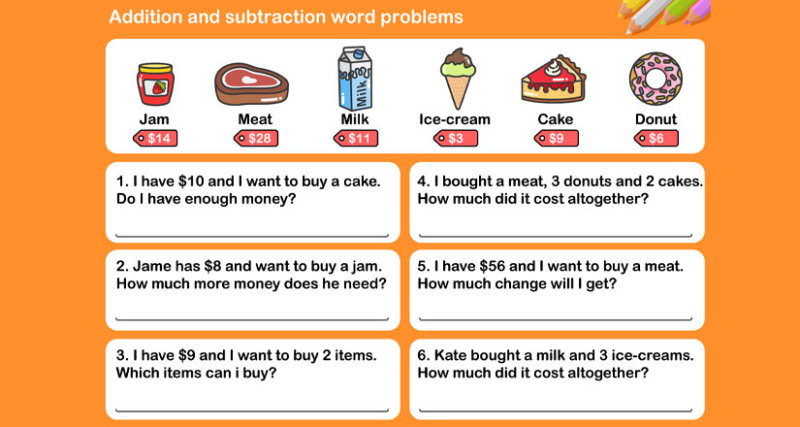The Problem with Word Problems
If your doctor gave you three pills and told you to take one every half hour, how long would they last you?
- Divide 30 by a half. What do you have?
- In a certain family, there are seven sisters and each sister has one brother. How many siblings are there?
Are you confident in your answers to these word problems? Read on to find out if you have the knack for overcoming the problem with word problems.
Teachers want their students to succeed so that both the teacher and student can feel a sense of accomplishment. It is discouraging to the instructor when they spend hours preparing and teach bell-to-bell only to get little or no results. Likewise, the students themselves become jaded as their confidence erodes and they feel like failures.
Problem solving is one of the most important components of the study of mathematics, as well as a significant component of the professional world. Problem solving permeates all aspects of our lives. It teaches us to be critical out-of-the-box thinkers, hones organizational skills, and builds a rational thought process required for making logical decisions. It is the hope that these problems solvers will someday pursue technical careers and become the engineers of the future.
When we look closely at the math section, we can see that it is with the word problem portion that students demonstrate the most difficulty and continue to show an overall lack of proficiency. One of the reasons for this weakness in achievement is that students have an inability to understand what is being asked, especially when the mathematics instruction includes abstract concepts.
Word problems tend to be complicated in part because of the descriptive language involved. Students need to find the useful information required to solve word problems. This requires translating the words into an equation. As a result, many elementary students find word problems to be the toughest types they face.
I hate to say this, but teachers do need to take some of the blame for the problem with word problems. If we trace our roots back to the earlier grade levels, I’m sure you have used key words to help students create the plan. For example, we might use a word like “more” as a clue for when to add. In a problem like “Three kittens curled up on a blanket. Four more kittens crawled onto the blanket. How many kittens are on the blanket now?” the word ‘more’ is a clue to use addition. However, if we rephrase the problem to “Seven kittens were cuddling on a blanket and some more crawled over to the blanket. Now there are twelve kittens. How many crawled over to the first seven?” The word ‘more’ ceases to designate addition. In fact, it’s the opposite. Here’s another sample: “Marcy has six fewer cats than Nancy. Marcy has twelve cats. How many does Nancy have?” The keyword ‘fewer’ indicates a subtraction problem, but it is not. Let’s try one more. “Some kittens were sleeping on the blanket. Seven woke up to have a snack. Now there are three on the blanket. How many were on the blanket to start?” No key word to follow here.
Research has shown that students show a lack of motivation to solve word problems because of the difficulty of the problems and the students’ inability to understand the structure of the word problem and finding an equation that coincides with the words or converting the problem into the correct operations. Other issues arise when students lack the basic fundamentals and cannot formulate a plan and separate steps. Each problem is unique in its own right and teachers cannot provide a single, overarching algorithm to solve them all.
Some remedies to the problem with word problems include the use of the classroom computer. The computer can be used as an instruction aid to teach mathematical word problem solving. By personalizing the word problems and creating realistic content based on real-world problems, computers tend to hold the interest of students longer than a lecture. Computers can adapt to the learner by generating questions tailored to the needs and capabilities of the student as well as provide immediate feedback and correct the student before numerous errors of the same type are made.
So what is the prescription for the problem with word problems? In my opinion it is this: expose the students to daily examples. Provide them with a guided experience by practicing the compartmentalizing of problems. Start with one step, then two, and three, and so on. Get back to the basics with the principles of mathematician George Pólya.
- Read the problem
- Understand what is being asked
- Make a plan to solve (the most difficult step)
- Execute the plan
- Check your solution for reasonableness
If all else fails, try to find a related problem and solve it. Then apply what you’ve discovered.
Solutions to introductory word problems:
- If your doctor gave you three pills and told you to take one every half hour, how long would they last you?
Answer: One hour (You take one immediately, then the second pill in thirty minutes, and the last pill thirty minutes after that).
- Divide 30 by a half. What do you have?
Answer: Sixty (Divide 30 BY a half, not IN half)
- In a certain family, there are seven sisters and each sister has one brother. How many siblings are there?
Answer: Eight (The seven sisters share the same brother)
- Christopher Masullo Ed.D.





